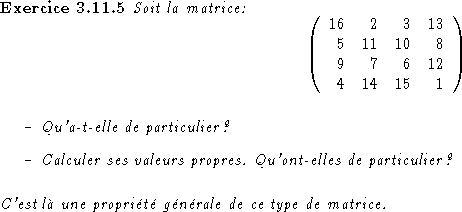
> with(linalg);A:=array([[1,2],[1,3]]); b:=array([1,-2]); : > linsolve(A,b); > A:=matrix(2,2,[a11,a12,a21,a22]);

Correction:
> alias(Id=&*())
> A1:= matrix(2,2,[a,b,c,d]):A2:=toeplitz([alpha,beta]):
> A3:=matrix(3,2,(i,j)-> i+j-1):
> evalm(A1+A2);evalm(3*A1-2*A2);evalm(A1-1);whattype(");
> # Attention a * qui est different de &*
> evalm(A1 &* 1/A1);evalm(A1 * (1/A1));evalm(A1^0));
![]()
Correction:> toep:=matrix([[1,0,0,1],[1,0,1,1],[0,0,1,0],[0,1,1,0]]); > trace(toep);det(toep); > rank(A);kernel(A);rowspace(A);colspace(A);

Correction:> with(linalg); > mat:=matrix(5,5,(i,j)->(x.i^(j-1))); > d:=det(mat); > factor(d);On ne peut pas utiliser factor sur un objet matriciel, c'est pourquoi la fonction map est nécéssaire.> mat:=matrix(3,3,(i,j)->(x.i^(j-1))); > i:=inverse(mat); > map(factor,i);

Correction:> with(linalg): > A:=matrix(3,3,[-4,-3,-1,2,1,1,4,-2,4]); > trace(A); > det(A); > transpose(A); > Id:= array(identity, 1..3,1..3); > pol1:=det(A-x*Id); > pol2:=charpoly(A,x); # = det(A-x*Id) > matcar:=charmat(A,x); # = A-x*Id

Correction:> B:=matrix(4,4,[16,2,3,13,5,11,10,8,9,7,6,12,4,14,15,1]); > valprop:=eigenvals(B);c'est un carré magique : somme des ligne et somme des colonnes sont constantes. Ce type de matrice a des valeurs propres toujours réelles.